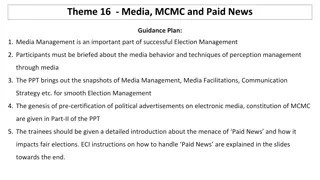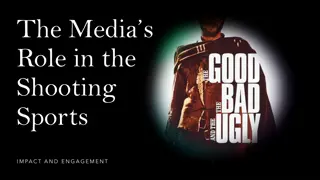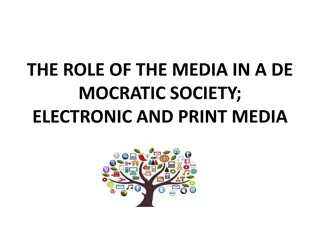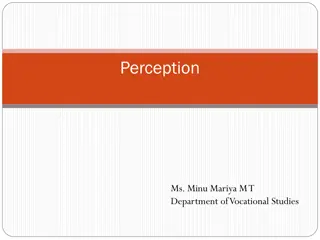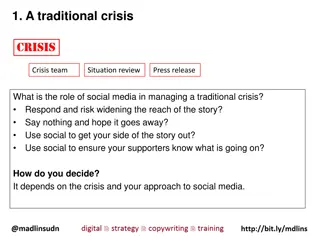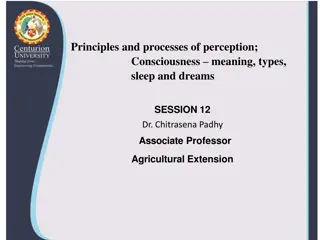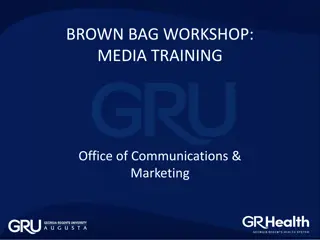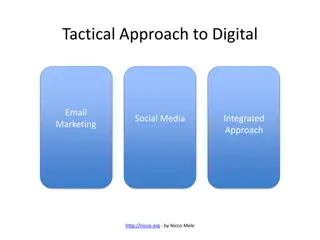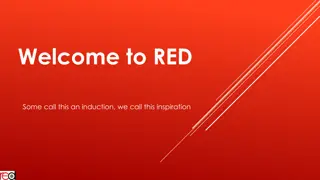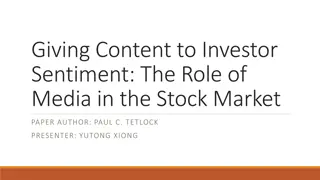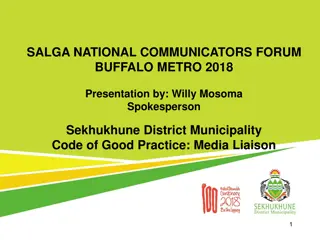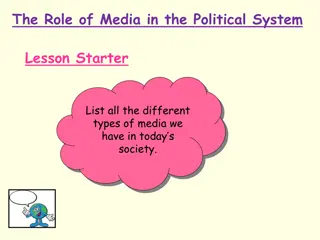Understanding the Role of Media Narratives in Shaping Market Perception
This paper delves into the impact of financial media narratives post-market crashes and their influence on collective memory, investor behavior, and market volatility. It highlights the association between crash narratives, market indicators, and investor responses, emphasizing the contagious nature of economic narratives and their role in shaping market sentiment. With insights on media virality, narrative choice subjectivity, and the influence of narratives on investor beliefs, it sheds light on the importance of understanding and analyzing media narratives in the financial landscape.
Download Presentation

Please find below an Image/Link to download the presentation.
The content on the website is provided AS IS for your information and personal use only. It may not be sold, licensed, or shared on other websites without obtaining consent from the author. Download presentation by click this link. If you encounter any issues during the download, it is possible that the publisher has removed the file from their server.
E N D
Presentation Transcript
Crash Narratives William Goetzmann (Yale), Dasol Kim (OFR), Bob Shiller (Yale) Financial Stability Conference November 17, 2022 The opinions and views of the authors do not necessarily reflect the positions or policies of the Office of Financial Research or the US Department of the Treasury.
Narratives in Collective Memory Few people experience extreme market crashes in their lifetimes, and most often rely on collective rather than personal memory. Collective memory is usually represented by narratives rather than comprehensive accounts. Narratives generally elicit causal relationships, providing analogies for how and why things happen, and what the future might be. Financial press is an important conduit. Journalists may use narratives to contextualize current events. Choice of narratives is subjective, and may not be necessarily congruent with actual conditions. Investors may rely on media narratives to form beliefs and inform choices, implying aggregate market feedback (Shiller, 2017). This paper examines the role of financial media in propagating narratives that may go viral.
Overview 1. Develop a measure of media narratives using articles published following major market crashes, i.e., crash narratives. 2. Strong association between crash narratives and traditional market- as well as survey-based crash indicators. 3. Evidence of virality of media narratives, feedback on market volatility. 4. Investors revise crash assessments following the appearance of crash narratives in media, and parrot the same language in written responses. 5. Media increases general or pure narrativity during periods of high investor attention. General narrativity drives main results.
Related Literature Financial and economic narratives. Bybee et al. (2021), Bertesch et. al. (2021), Larsen et. al. (2021), Dierckx et al. (2021). Rare disasters. Reitz (1988), Barro (2006), Weitzmann (2007), Santa-Clara & Yan (2010), Berkman et. al. (2011), Bollerslev & Todorov (2011), Wachter (2013), Welch (2015), Goetzmann, Kim & Shiller (2022). Memory models. Mullainathan (2002), Gennaioli and Shleifer (2010), Kahana (2012), Bordalo et. al. (2017), Enke et. al. (2019), Wachter and Kahana (2019), Goetzmann, Watanabe & Watanabe (2022).
What is a Narrative? Economic narratives are contagious stories with the potential to change how people make economic decisions independent of fundamentals (Shiller, 2019). Narrativity is a set of qualities or properties that distinguishes narratives from non-narrative texts (Herman, 2009): 1. Situatedness (voice indicating occasion for telling) 2. Relevance of event sequencing (causality) 3. Worldmaking, disruption (disequilibrium) 4. What it s like (experience of story-world) Quantifying narratives (or narrativity) is intrinsically difficult as it involves high-dimensional semantic representations.
Example: September 16, 2008 Article from September 16, 2008: If you learn nothing else from the last few harrowing days, you should learn the difference between what is obvious and what is inevitable. In the heat of the moment, the two perceptions seem identical. It was obvious that investors would panic as they absorbed the news about Bloody Sunday on Wall Street, so it was inevitable that the market would take a slashing. It was obvious that Lehman Brothers had to go bust, so a bankruptcy filing was inevitable. It was obvious that Merrill Lynch could no longer make it on its own, so it was inevitable that a bigger institution like Bank of America would take it over. But investors -- at least individual investors -- don't actually panic in times like these. Instead, they freeze. In July (the latest month for which final numbers are available), mutual-fund investors pulled out just $2.62 of every $100 they had invested in stock funds. That was less than they took out of bond funds, even though the stock market had just gone through a nauseating summer swoon. [...]
Quantifying Crash Narratives Recent advances in computational linguistics potentially provide a way of quantifying narratives. Distributional Hypothesis: Linguistic terms with similar distributions (used or occur in same contexts) can purport similar meanings. Statistical semantics builds on this to provide mathematical representations of ideas based on sequencing of words, sentences, etc. If we can properly model the distributed semantic representations (for subjective accounts of stock market crashes), it may be possible to identify the narrativity (crash narratives) broadly.
Quantifying Crash Narratives (cont.) Our main approach is based on established distributional semantic methods that allows us compare semantic similarity across articles over time. Doc2Vec (Le & Mikolov, 2014) is based on neural network modeling to create distributed semantic representations of words, paragraphs, etc. Evidence of effectiveness for classifying narratives (Dehghani et. al., 2017). Complementary to other approaches (e.g., BERT) We focus on periods rich in crash narratives: periods immediately following stock market crashes (e.g., Black Monday). Use Doc2Vec to quantify semantic structures and compare the similarity in those structures across periods. Evolving lexicon of financial press standardization 87 Narrative = (Cosine Similaritywith Articles on Oct. 20 - 23, 1987) - (Cosine Similarity with Articles on Oct. 5 - 9, 1987)
Example: September 16, 2008(cont.) BEST matched article from Oct 20, 1987 to Sept 16, 2008 example: The little investor doesn't know where to turn, although bigger ones are putting up a brave front. "I'm scared," says Julie Ianotti, an executive secretary in Houston. "My stock is my nest egg, for a house or something. Should I sell? Tell me, should I sell?" When Ms. Ianotti's mother suggested the price drop could portend a new depression, the young Ms. Ianotti at first scoffed at the idea. "I said, 'Yeah, sure, Mom. It'll go back up.'" But as the Dow Jones Industrial Average was taking a record plunge yesterday, Ms. Ianotti says she began giving more thought to her mother's stories about subsisting on water and sugar in the Depression. [...]
Example: September 16, 2008(cont.) WORST matched article from Oct 20, 1987 to Sept 6, 2008 example: IC Industries Inc., expanding a restructuring of the company, said it will buy as much as $1 billion of its common shares and is considering selling its aerospace unit, valued at more than $1.5 billion. Karl D. Bays, chairman and chief executive officer, said the moves are being undertaken to focus the company around its most profitable businesses, which include food products, soft-drink bottling and auto repair. He said the steps aren't related to recent market reports that Minneapolis investors Irwin Jacobs and Carl Pohlad may seek control of the company. In September, IC announced plans to divest its Illinois Central Gulf Railroad unit by distributing shares in the division to IC holders. It estimated the railroad's market value at $250 million. [...]
Prevalence of Crash Narratives 5 Sep. 2008: Lehman Collapse Sep. 1998: Russian Crisis / LTCM Collapse Sep. 2001: 9/11 Oct. 1987: Black Monday 4 Mar. 2020: COVID-19 3 Nov. 1997: Asian Financial Crisis 2 Standardized 1 0 -1 -2 Oct. 1989: Fri 13th Aug. 2011: Euro Crisis -3 -4 1987 1990 1993 1996 1999 2002 2005 2008 2011 2014 2017 2020 Minimum Return Maket Volatility VIX Crash Probability (Option) '87 Narrative Crash Probability (Survey)
Data Financial News data: ProQuest Wall Street Journal Eastern Edition (1984 2020). 231,230 articles. Hand-collected Wall Street Journal data from 1929. Investor survey data: Investor Behavior Project (Shiller Survey). 19,426 responses (1989 2020). Crash probability estimates, general comments, date of response, investor type (i.e. individual, institutional). Internet search data: Google Trends API.
1. How Do Narratives Propagate? Assess virality using internet search volumes (Da et al., 2011). Investor interest related to crashes (CrashAttention) should be higher after seeing crash narratives in financial press. Effects should be conditioned on general stock market attention. Aggregate search volumes, not user-level. Model specification: CrashAttentiont+1 = 1 87 Narrativet+ 2 StockMarketAttentiont + 3 87 Narrativet StockMarketAttentiont + j=15 4,j Xt-j+1 + j=15 5,j CrashAttentiont-j+1 + DOWt+ Montht+ t+1 Control variables (X): VIX, option-implied crash probabilities, market returns, market volatility, turnover.
1. Result: Propagation (1) (2) (3) (4) Crash Attentiont+1 Crash Attentiont+1 Crash Attentiont+1 Crash Attention (Dummy)t+1 Dependent Variable: '87 Narrativet StockMarketAttentiont '87 Narrativet StockMarketAttentiont 8.790*** 5.739** 0.124*** 4.334*** 5.618** 0.104*** 4.515*** 6.971*** 0.137*** 2.078*** Lagged Crash Attention Terms Control Variables Month and Day-of-week FEs YES NO NO YES NO NO YES YES YES YES YES YES Evidence of positive feedback loop related to media narratives. Other results: i. Weaker effects for crash narratives from 29 crash (salience). ii. Crash narratives have positive feedback on market volatility.
2. Do Narratives Affect Investor Beliefs? Fundamental news captured by the narrative measure will likely affect individual and institutional investors similarly. However, individuals may rely more on judgement heuristics when expertise low (Ottati & Isbell, 1996; Isbell & Wyer, 1999). Focus on differential effect based on investor sophistication. Model specification (by investor type): Adji,t = 1 87 Narrativet-1+ 2 StockMarketAttentiont-1 + 3 87 Narrativet-1 StockMarketAttentiont-1 + 4 Wi,t-1 + DOWt+ Year-Montht + i,t Adjusted crash probabilities ( Adj): survey crash probability minus option- implied crash probability. Control variables (W): VIX, market returns, past month market returns, market volatility, past month survey probabilities, past month stock market attention, past month crash narratives.
2. Result: Investor Crash Beliefs (1) Indiv. Adji,t+1 (2) Inst. Adji,t+1 (3) All Investor Subsample: Dependent Variable: Adji,t+1 '87 Narrativet StockMarketAttentiont '87 Narrativet StockMarketAttentiont Institutionali Institutionali '87 Narrativet Institutionali StockMarketAttentiont Institutionali '87 Narrativet StockMarketAttentiont -0.084 0.001 0.504*** -0.257 0.006** -0.133 0.231 0.004** 0.566*** -0.025*** -0.002 -0.768* -0.740*** Control Variables Year-Month and Day-of-week FEs YES YES YES YES YES YES Individual investors adjust crash probabilities in response to crash narratives, but not institutional investors. Other results: i. Bag-of-words measures have little impact on investor assessments. ii. Investors parrot crash narratives in general assessments.
3. When Does Media Use Narratives? Pure narrativity that is plausibly exogenous to the financial markets. Brothers Grimm Fairy Tales widely used as archetypal narrative corpora. Stories by motif category, estimate similarity with each WSJ article. Use the first principal component factor to capture general narrativity. We find evidence (not shown) that journalists use narratives to make information more accessible during periods of broader readership. Allows us to directly assess whether the crash narrative results are actually due to narrativity rather than other factors.
3. Pure Narrativity (FolkMotif) 5 4 3 2 Standardized 1 0 -1 -2 -3 -4 1987 1990 1993 1996 1999 2002 2005 2008 2011 2014 2017 2020 '87 Narrative FolkMotif High correlation between crash and pure narratives measures: ~90%
3. Result: Narrativity, Investor Beliefs (1) Indiv. Adji,t+1 (2) Inst. Adji,t+1 (3) Indiv. Adji,t+1 (4) Inst. Adji,t+1 Investor Subsample: Dependent Variable: FolkMotift StockMarketAttentiont FolkMotift StockMarketAttentiont FolkMotiftCrash FolkMotiftCrash StockMarketAttentiont FolkMotiftNon-crash FolkMotiftNon-crash StockMarketAttentiont 0.002 0.002 0.003** -0.002 0.005 -0.002 -0.002 0.006** 0.004 0.001 -0.003 -0.001 -0.002 -0.002 Control Variables Year-Month and Day-of-week FEs YES YES YES YES YES YES YES YES Effects isolated to component related to pure narratives, confirming that the main results are related to narrativity.
Closing History plays an important role in press narratives by bringing attention to past rare events in U.S. stock market history. Our results suggest investors rely on narrative heuristics in forming beliefs, affecting aggregate market outcomes. Collective and individual memory processes are not mutually exclusive. Stories may also be a mechanism to perpetuate a particularly important event in individual memory. Interactions between collective and individual memory processes are not well understood.






